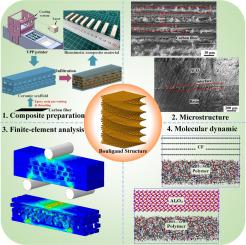制备 Bouligand 生物仿生陶瓷复合材料以及不同纤维取向对机械性能的影响
IF 6.1
1区 工程技术
Q1 ENGINEERING, MANUFACTURING
引用次数: 0
摘要
Bouligand 结构的多级螺旋排列使其在承受外部应力时具有优异的机械性能。本研究采用大桶光聚合(VPP)3D 打印技术制备了具有 Bouligand 结构和连续碳纤维的 Al2O3 陶瓷支架。采用环氧树脂渗透法制备了一系列具有不同纤维取向的仿生物布利根-陶瓷基复合材料。评估了复合材料在不同纤维起始角和旋转角下的抗弯强度、断裂韧性和断裂功。利用有限元法和周动力学模拟揭示了不同纤维排列对复合材料裂纹扩展模式的影响。分子动力学模拟、扫描电子显微镜和能量色散光谱分析揭示了材料的微观结构和界面结合特性。实验结果表明,特定的起始角和旋转角组合可有效促进断裂过程中的裂纹扭转,从而增加断裂能量在零件中的耗散并提高其断裂韧性。本研究利用快速成型技术,通过简单灵活的生产工艺,克服了制造复杂仿生结构的难题。这种方法为开发轻质、高强度和高韧性仿生材料提供了实用的解决方案。本文章由计算机程序翻译,如有差异,请以英文原文为准。

Preparation of Bouligand biomimetic ceramic composites and the effect of different fiber orientations on mechanical properties
The multilevel helical arrangement of the Bouligand structure endows it with excellent mechanical properties when subjected to external stresses. In this study, Al2O3 ceramic scaffolds with Bouligand structures incorporated with continuous carbon fibers were prepared using vat photopolymerization (VPP) 3D printing technology. A series of biomimetic Bouligand–ceramic matrix composites with different fiber orientations were prepared using the epoxy penetration method. The flexural strength, fracture toughness, and work of fracture of the composites were evaluated at different fiber initiation and rotation angles. The effects of different fiber arrangements on the crack extension mode of the composites were revealed using the finite element method and peridynamics dynamics simulations. Molecular dynamics simulations, scanning electron microscopy, and energy-dispersive spectroscopy analyses revealed the material microstructure and interfacial bonding properties. The experimental results indicated that a specific combination of initiation and rotation angles can effectively promote crack twisting during the fracture process, thereby increasing the dissipation of fracture energy in the part and improving its fracture toughness. In this study, additive manufacturing technology was used to overcome the challenges of fabricating complex bionic structures through a simple and flexible production process. This method provides a practical solution for the development of lightweight, high-strength, and high-toughness bionic materials.
求助全文
通过发布文献求助,成功后即可免费获取论文全文。
去求助
来源期刊

Journal of Manufacturing Processes
ENGINEERING, MANUFACTURING-
CiteScore
10.20
自引率
11.30%
发文量
833
审稿时长
50 days
期刊介绍:
The aim of the Journal of Manufacturing Processes (JMP) is to exchange current and future directions of manufacturing processes research, development and implementation, and to publish archival scholarly literature with a view to advancing state-of-the-art manufacturing processes and encouraging innovation for developing new and efficient processes. The journal will also publish from other research communities for rapid communication of innovative new concepts. Special-topic issues on emerging technologies and invited papers will also be published.
 求助内容:
求助内容: 应助结果提醒方式:
应助结果提醒方式:


